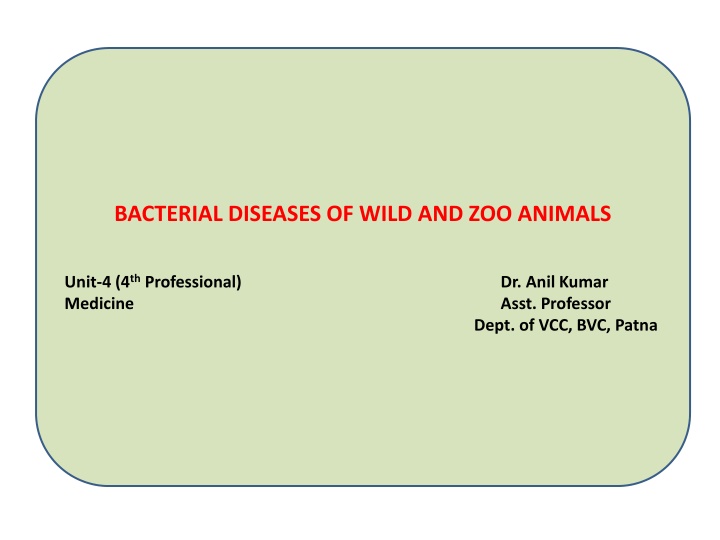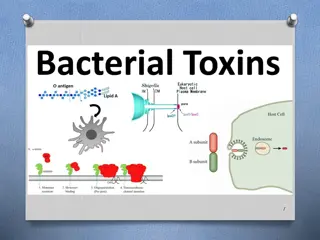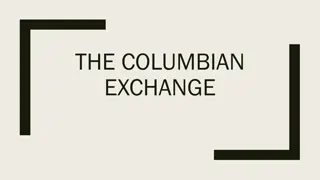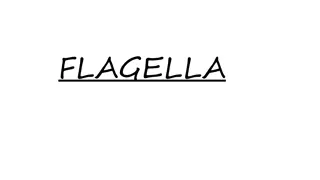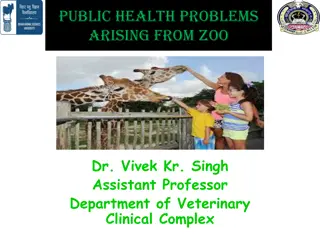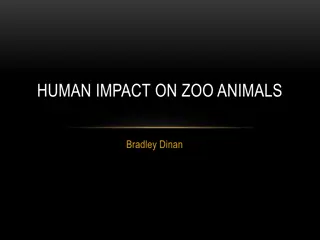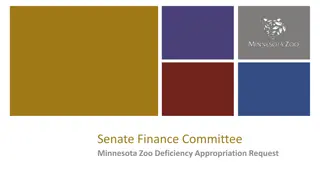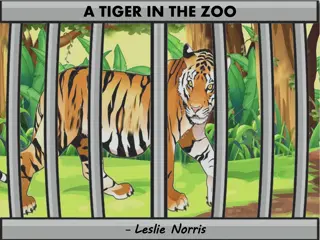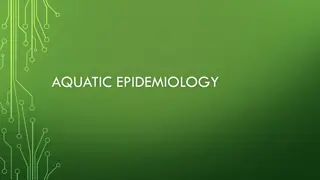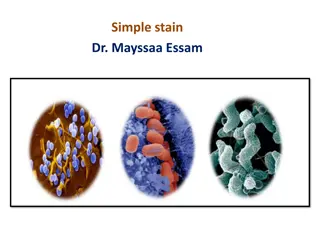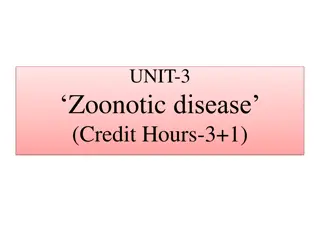Bacterial Diseases Impacting Wild and Zoo Animals: An Overview
Learn about anthrax, tuberculosis, and salmonellosis, three significant bacterial diseases affecting wild and zoo animals. Understand their etiology, hosts, transmission, diagnosis, prevention, and treatment to safeguard animal populations effectively.
Download Presentation

Please find below an Image/Link to download the presentation.
The content on the website is provided AS IS for your information and personal use only. It may not be sold, licensed, or shared on other websites without obtaining consent from the author.If you encounter any issues during the download, it is possible that the publisher has removed the file from their server.
You are allowed to download the files provided on this website for personal or commercial use, subject to the condition that they are used lawfully. All files are the property of their respective owners.
The content on the website is provided AS IS for your information and personal use only. It may not be sold, licensed, or shared on other websites without obtaining consent from the author.
E N D
Presentation Transcript
BACTERIAL DISEASES OF WILD AND ZOO ANIMALS Unit-4 (4th Professional) Medicine Dept. of VCC, BVC, Patna Dr. Anil Kumar Asst. Professor
ANTHRTAX Etiology: Bacillus anthracis Host affected: Primarily a disease of mammals and most prevalent in herbivores especially in ruminants. Incidental outbreak occurs in Carnivores and Omnivores. Source of infection: Anthrax spores present in affected animal carcasses and in old livestock burial places. Anthrax continues as endemic/ epidemic in many Wildlife protected areas of the world. Transmission: Sporulation occurs when a fresh infected carcass is opened and exposed to surrounding oxygen in the air. Putrefactive organism generally dies in the tissue of a carcass if unopened.
Diagnosis: In herbivores, the animal die suddenly without showing any sign of illness in per acute and acute cases. Oozing of blood is seen from natural orifices after death of animal. Omnivore and Carnivores usually suffer from sub acute to chronic form of disease showing subcutaneous edematous swelling of the face, throat and neck. Laboratory diagnosis: Isolation of organism. Prevention and management: Vaccination of domesticated animals having past record of the disease around the protected area. Carcass should not be opened if suspected for Anthrax. Carcass should be deep buried using disinfectant material. Disinfect the surface area contaminated by carcass. Treatment: No scope for treatment due to sudden death.
TUBERCULOSIS Etiology:Mycobacterium tuberculosis; M. bovis Animals affected: Free ranging wild animals are rarely affected. The disease is common in Asian Elephants, Deers, Bison, Primates, Hippopotamus, Rhinoceros, Giraffe, Ostrich. Occasionally, captive carnivores i.e. Common Leopard, Snow Leopard, Lion and Tiger are also affected by Mycobacterium bovis which is probably due to eating of contaminated meat. African Elephants are rarely affected by this disease. Source of infection: Infection is caused by contact with infected human or non human primate. Rhesus monkeys are particularly susceptible to this disease and are the major source of infection. Transmitted by nasal discharge, lacrimal secretion of infected animal. Also through contaminated food and water.
Diagnosis: Progressive illness with coughing, weight loss, off-fed, and lethargy. Laboratory diagnosis: Cytological examination and culture of respiratory secretion. Prevention and management: Control of the disease is depending on early detection and removal of infected animal from the herd of Zoological collections. Balance food in hygienic condition is advisable. Treatment: Segregation Treatment with drug combination of Ethambutol, Isoniazid, Pyrazinamide and Refampicin at least for a period of 6 month advisable
SALMONELLOSIS Causative organism: Salmonella enteritidis Animals affected: Zoological collection animals are exposed to Salmonellosis very often. Salmonellosis is cause of enteritis in most cases of One horned Asian Rhinoceros. Source of infection: Ingestion of contaminated food and water and direct contact with infected and shedding animals. Diagnosis: Mild enteritis with vomiting and diarrhoea. If the disease is severe, anorexia, lethargy, dehydration may be seen. Laboratory diagnosis: Culture of fresh fecal material.
Prevention and management: Eradication and control of Salmonellosis is not a easy job however, proper hygiene, sanitation, collection management shall be helpful. Treatment: Supportive treatment is recommended in mild acute cases. Enrofloxacin, Ciprofloxacin, Ampicillin, Getamicin, Amoxicillin, Trimethoprim/Sulfonamides are recommended for treatment of Salmonellosis. Use of antibiotic in Salmonellosis is controversial as the drugs do not eliminate Salmonella bacteria.
LEPTPSPIROSIS Causative organism: Leptospires (Slender gram negative aerobes) Animals affected: Most species of mammals Source of infection: Direct or indirect contact with infected urine, placental fluid and milk. Diagnosis: It is difficult to diagnose the disease clinically. Laboratory diagnosis: Serological test Prevention and management: Prevention of this disease in captive animals is almost impossible. Quarantine period should be sufficient to detect the disease. Vaccination is also not possible due to high risk of public health. Treatment: Antimicrobial therapy is suggested.
CLOSTRIDIAL DISEASES Causative organism: Clostridium perfringens Animals affected: Most species of mammals Diagnosis: Diarrhea, dysentery ,Sudden death. Laboratory diagnosis: ELISA Test Prevention and management: Prophylactic antibiotic therapy is suggested in case of outbreak. Eliminating predisposing factor and maintaining hygiene are the prime factor for preventing the disease. Treatment: Intravenous broad-spectrum antibiotic.
TETANUS Clostridial organisms cause this condition in which muscular rigidity is the prominent feature. This is commonly noticed in captive elephants that met with injuries, non-human primates etc. In case of affected elephants, this caused death in large number of elephants. Clinical symptoms comprise diarrhea, loss of appetite, listlessness and death. The therapy consists of administration of antitoxins and high levels of antibiotics
COLIBACILLOSIS These infections are caused by Escherichia coli organisms affecting the wide variety of birds as well as the mammals esp. the neonatal animals. Incidences have been found through out the world among the various wild animal species. Fecal-oral route is the mode of transmission of these organisms, in most of the conditions. Enteritis occur in the affected wild animal species. The culture tests may assist the confirmation of this microbial infections.
